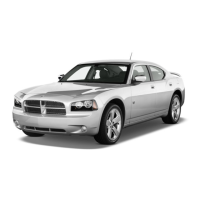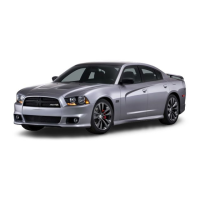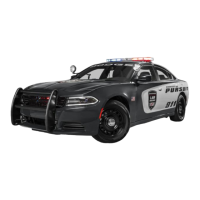Do you have a question about the Dodge Charger 2011 and is the answer not in the manual?
This manual contains WARNINGS against operating procedures that could result in collision or bodily injury.
Your vehicle uses a keyless ignition system consisting of a Key Fob with Remote Keyless Entry and a Keyless Ignition Node.
The Sentry Key Immobilizer System prevents unauthorized vehicle operation by disabling the engine.
Monitors vehicle doors and ignition switch for unauthorized entry or operation, providing audible and visible signals if triggered.
Passive Entry system allows door locking/unlocking without using RKE transmitter buttons.
Details seat belts, airbags, pretensioners, and child restraint systems.
Explains lap/shoulder belt operation, proper usage, and warnings.
Provides guidance on using child seats, LATCH systems, and booster seats.
System uses radar sensors to detect vehicles in blind spots, providing visual and audible alerts.
Aids drivers backing out of parking spaces by detecting approaching vehicles.
Voice-activated, hands-free system for dialing, call logs, contacts, and more.
Explains how to use voice commands for various vehicle functions.
System automatically turns headlights on/off based on ambient light levels.
Covers auto door lock, auto unlock on exit, flash lights, sound horn, and key fob unlock order.
Allows locking/unlocking doors without pressing RKE transmitter buttons.
Details paired devices, SIRIUS setup, and subscription information.
Enables music streaming from cellular phone to the Uconnect™ phone system.
Details operation of air conditioning and heating system via instrument panel or Uconnect Touch™.
Details shift lever positions, starting procedures, and cautions for transmission damage.
Guidance on acceleration and traction on wet, icy, or snowy roads.
Explains ABS function, EBD, and normal operating sounds.
Details ABS, TCS, BAS, and ESC systems for vehicle stability and control.
Enhances directional control by applying brakes or reducing engine power.
Covers tire markings, size designations, and safety precautions.
Explains proper cold tire inflation pressure and its relation to temperature changes.
Recommends using equivalent tires and warns against unapproved sizes or load ratings.
Warns driver of low tire pressure and explains system operation and warnings.
Precautions to prevent carbon monoxide poisoning from exhaust gases.
Information on vehicle load capacity, GVWR, and GAWR.
Safety tips and information on towing limits for your vehicle.
Steps to reduce overheating potential on highways and in city traffic.
Safety warnings and procedures for changing a tire.
Detailed warnings and steps for safely changing a tire.
Guidance on towing procedures for disabled vehicles, including RWD and AWD models.
Monitors emissions, engine, and transmission systems; alerts driver via Malfunction Indicator Light (MIL).
Contains required maintenance services determined by engineers for optimal performance.
Covers checking oil level, change intervals, and oil selection for different engines.
Information on protecting the cooling system, coolant checks, and warnings.
Details periodic inspection of brake components for performance assurance.
Instructions on checking the brake fluid level and warnings about proper fluid type.
Scheduled maintenance services to protect vehicle warranty and ensure optimal performance.
Information on contacting authorized dealers and manufacturer customer centers.
This manual contains WARNINGS against operating procedures that could result in collision or bodily injury.
Your vehicle uses a keyless ignition system consisting of a Key Fob with Remote Keyless Entry and a Keyless Ignition Node.
The Sentry Key Immobilizer System prevents unauthorized vehicle operation by disabling the engine.
Monitors vehicle doors and ignition switch for unauthorized entry or operation, providing audible and visible signals if triggered.
Passive Entry system allows door locking/unlocking without using RKE transmitter buttons.
Details seat belts, airbags, pretensioners, and child restraint systems.
Explains lap/shoulder belt operation, proper usage, and warnings.
Provides guidance on using child seats, LATCH systems, and booster seats.
System uses radar sensors to detect vehicles in blind spots, providing visual and audible alerts.
Aids drivers backing out of parking spaces by detecting approaching vehicles.
Voice-activated, hands-free system for dialing, call logs, contacts, and more.
Explains how to use voice commands for various vehicle functions.
System automatically turns headlights on/off based on ambient light levels.
Covers auto door lock, auto unlock on exit, flash lights, sound horn, and key fob unlock order.
Allows locking/unlocking doors without pressing RKE transmitter buttons.
Details paired devices, SIRIUS setup, and subscription information.
Enables music streaming from cellular phone to the Uconnect™ phone system.
Details operation of air conditioning and heating system via instrument panel or Uconnect Touch™.
Details shift lever positions, starting procedures, and cautions for transmission damage.
Guidance on acceleration and traction on wet, icy, or snowy roads.
Explains ABS function, EBD, and normal operating sounds.
Details ABS, TCS, BAS, and ESC systems for vehicle stability and control.
Enhances directional control by applying brakes or reducing engine power.
Covers tire markings, size designations, and safety precautions.
Explains proper cold tire inflation pressure and its relation to temperature changes.
Recommends using equivalent tires and warns against unapproved sizes or load ratings.
Warns driver of low tire pressure and explains system operation and warnings.
Precautions to prevent carbon monoxide poisoning from exhaust gases.
Information on vehicle load capacity, GVWR, and GAWR.
Safety tips and information on towing limits for your vehicle.
Steps to reduce overheating potential on highways and in city traffic.
Safety warnings and procedures for changing a tire.
Detailed warnings and steps for safely changing a tire.
Guidance on towing procedures for disabled vehicles, including RWD and AWD models.
Monitors emissions, engine, and transmission systems; alerts driver via Malfunction Indicator Light (MIL).
Contains required maintenance services determined by engineers for optimal performance.
Covers checking oil level, change intervals, and oil selection for different engines.
Information on protecting the cooling system, coolant checks, and warnings.
Details periodic inspection of brake components for performance assurance.
Instructions on checking the brake fluid level and warnings about proper fluid type.
Scheduled maintenance services to protect vehicle warranty and ensure optimal performance.
Information on contacting authorized dealers and manufacturer customer centers.
| Brand | Dodge |
|---|---|
| Model | Charger 2011 |
| Category | Automobile |
| Language | English |











